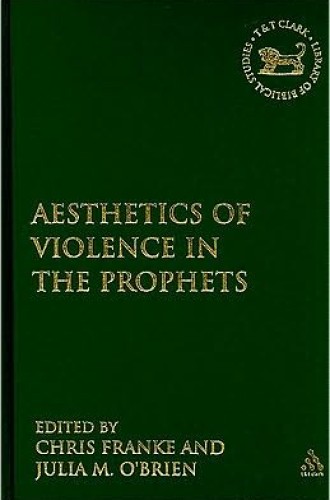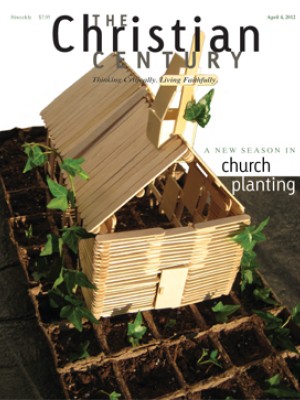The Aesthetics of Violence in the Prophets, edited by Chris Franke and Julia M. O'Brien
Lately there has been a surge of studies variously construed as focused on "religion and violence," "the Bible and violence" or "God and violence." Most of these studies are not very helpful, for they dismiss the shrill reality of violence in facile ways. Among the strategies of dismissal are an evolutionary hypothesis that religion has outgrown such primitivism, assertions that texts must be taken symbolically rather than literally, and a flat-out Marcionite maneuver that selects the good stuff and rejects the negative—a move that produces what Yvonne Sherwood, in this edited collection, terms "the Liberal Bible":
The Liberal Bible . . . represented a compromise settlement between the Bible and proto-democracy and signalled the transformation of Bible from a complex and variegated text to a cultural symbol or icon—a reduction of Bible to a few axiomatic politico-theological principles that could be liberally applied. . . . The Liberal Bible maintained that true scripture must be ethical and legal; it supported the universal and denounced the arbitrary and capricious; and it supported consensus and consultation and shunned acts of sovereign exceptionality and raw force.
Read our latest issue or browse back issues.
The Aesthetics of Violence in the Prophets is unlike such dismissive trivialization. It takes violent rhetoric seriously as a powerful datum of the Bible that is substantive and intentional and not as simply an embarrassing side issue. The book consists of nine essays by scholars who are skilled in theory and are acute in their interpretive capacity and theological sensibility.
The collection emerged from a section of the Society of Biblical Literature in which these scholars labored almost unnoticed for years until they went public with their findings. The production of the book is a testimony to what is entailed in serious study: we get a picture of these scholars meeting year after year in a small hotel room, sharing their work and encouraging each other to move beyond usual assumptions. The volume is an invitation to think again about violence in the Bible—not to dismiss it as objectionable and unacceptable, but to recognize it as an inescapable vehicle for saying what must be said in a society narcotized by denial and despair.
The focus is on the prophetic rhetoric of the Hebrew Bible/Old Testament, and the defining word in the title is aesthetics. The contributors understand the violent rhetoric in the prophetic literature not as a collection of revelatory divine utterances but as strategic, artistic articulations of reality that were designed to exhibit and construe vexed, disordered lived experience that is beyond easy management or understanding.
The most programmatic essay in the collection is Sherwood's. She writes about the "Literary Bible" as well as the Liberal Bible. The former is an academic exercise in "Romanticism and Rhetoric." Appealing to poet Sylvia Plath's poignant formula about words as axes, Sherwood takes prophetic words to be an ax of dangerous divine sovereignty that comes when one (God?) "acts as if one were alone to act":
The word and voice of God is performed as massive, irresistible, unanswerable, hypermasculine—a world away from the collaborative environment of the Liberal and Literary Bibles, with their models of reader-response. . . . God makes himself felt in the world as an irresistible force meeting an infinitely movable and impressionable object.
That rhetoric, moreover, must appeal to bodily imagery of a hard, wounding kind in order to draw close to the lived reality of an unbearable social reality that will not be covered over by smooth speech, pious doctrine or elite cant. These essays show Israel's obstreperous poets limning the intolerable social reality that becomes an arena for death-dealing, life-conjuring holiness. They are forceful because they are intensely text-specific; they show us how the artistry of fierce rage can be addressed to a society in more trouble than it is able to acknowledge.
Kathleen O'Connor probes the war poetry of Jeremiah as survival literature, with its inescapable rhetoric concerning the abuse and rape of women:
The divine violence proclaims that life is not utterly random, that God is not powerless, and that people have some control as actors in their life. They are the punished ones, but the system itself has meaning. For survivors of cultural collapse, this is a word of salvation.
Carolyn Sharp, in reflecting on the artistry of Hosea, shows the way in which allusion to place names serves as a reminder of social failure. She shows that in his "God Damn America" sermon, Jeremiah Wright was doing with American memory what Hosea was doing with Israelite memory.
Daniel Smith-Christopher considers oracles of judgment in Micah and shows how the later rhetoric of Stokely Carmichael of the Student Nonviolent Coordinating Committee was a parallel to Micah. Both Micah and Carmichael used violent rhetoric in the service of a nonviolent assault on "useless" urban structures, which were countered by "useful" peasant work.
Mary Mills takes up the divine violence in the book of Amos against the predatory violence of the urban elites in Samaria. The outrageousness of the imagery is essential for penetrating the self-assured power of the predatory class.
Julia O'Brien considers the graphic violence of the poetry of Nahum and draws parallels to contemporary film, notably films about the Vietnam War, to make visually available a world of atrocity in which sustainable meaning is not obvious or easy.
The authors show that rhetorical violence is a strategy for revealing what we characteristically choose not to notice. Contributor Robert Haak notes regarding violent language:
In a time of victory, it can temper our tendency to claim total control of power. In a time of threat it can provide hope and direction for a suitable outcome. In a time of defeat, it can provide a matrix of meaning from which a new life can be built.
Characteristic of their guild and in tune with current theory, these scholars do not do theology that witnesses to the "real God." They assume that in these texts God is an artistic fiction constructed in an ongoing work of telling truth and giving hope—work that requires extremity in order to break the grip of totalizing ideology. It may be that theologically serious interpreters will push beyond this to the "real God." Or it may be that we can recognize, through these perspicacious analyses, that our best belief is always partly a matter of imaginative construal.
Either way, these essays push us beyond the old liberal notion that the prophets finally arrived at an ethical monotheism that recognized the "brotherhood of man" under "the fatherhood of God." Such a familiar formula indicates the way in which we conform our reading to our ideological permits. In time, no doubt, we will come to ponder more closely the ideological permits in the approach of these authors. But for now their essays are a compelling reminder of the hard work that is required by serious faith. The God of these texts is no nice uncle but a pulsing holiness beyond our best rationality—or even beyond our good will.







